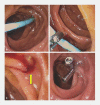A rare complication of ERCP: duodenal perforation due to biliary stent migration
- PMID: 33140007
- PMCID: PMC7577786
- DOI: 10.1055/a-1231-4758
A rare complication of ERCP: duodenal perforation due to biliary stent migration
Abstract
Background and study aims Perforation of the duodenal wall opposing the major papilla due to a migrated pancreatobiliary stent rarely has been described in the literature as a complication of endoscopic retrograde cholangiopancreatography (ERCP). Factors associated with perforation from migrated stents from ERCP are unknown. Patients and methods This was a retrospective, observational study. Patients were identified from January 1, 1994 to May 31, 2019 in a prospectively maintained ERCP database. Results Eleven cases of duodenal perforation from migrated pancreatobiliary stents placed at ERCP were identified during the study period. All cases involved biliary stents, placed for biliary stricture management. The perforating stent was plastic in 10 cases (91 %). This complication occurred in one in 2,293 ERCP procedures in which a pancreatobiliary stent was placed. Conclusion This complication is more common with biliary stents compared to pancreatic stents. This may be related to the angle of exit of biliary stents being more perpendicular to the opposing duodenal wall and the near exclusive use of external pigtail plastic stents in the pancreatic duct. All perforating plastic stents were ≥ 9 cm in length. Longer stents may provide leverage for perforation with a migration event.
The Author(s). This is an open access article published by Thieme under the terms of the Creative Commons Attribution-NonDerivative-NonCommercial License, permitting copying and reproduction so long as the original work is given appropriate credit. Contents may not be used for commecial purposes, or adapted, remixed, transformed or built upon. (https://creativecommons.org/licenses/by-nc-nd/4.0/).
Conflict of interest statement
Competing interests Dr. Lehman is a consultant for Cook Medical. Dr. Sherman is a consultant for Cook Medical, Olympus America, and Boston Scientific. Dr. Gromski is a consultant for Boston Scientific. Dr. Easler is a consultant for Boston Scientific.
Figures



Similar articles
-
Sigmoid colon perforation caused by migrated plastic biliary stents: a case report.Int J Colorectal Dis. 2021 Jan;36(1):199-201. doi: 10.1007/s00384-020-03728-2. Epub 2020 Aug 31. Int J Colorectal Dis. 2021. PMID: 32865713 Review.
-
Conservative Treatment of Sigmoid Diverticulum Perforation Secondary to Migrated Biliary Plastic Prostheses Inserted by Endoscopic Retrograde Cholangiopancreatography: A Case Report of an Unusual Adverse Event and Literature Review.Cureus. 2025 Feb 15;17(2):e79042. doi: 10.7759/cureus.79042. eCollection 2025 Feb. Cureus. 2025. PMID: 40099079 Free PMC article.
-
Analysis of high risk factors for endoscopic retrograde cholangiopancreatography biliary metallic stenting after malignant duodenal stricture SEMS implantation.J Biol Regul Homeost Agents. 2016 Jul-Sep;30(3):743-748. J Biol Regul Homeost Agents. 2016. PMID: 27655491
-
Bowel Perforation Caused by Biliary Stent Migration After ERCP: A Systematic Review.J Clin Gastroenterol. 2025 May-Jun 01;59(5):472-478. doi: 10.1097/MCG.0000000000002029. Epub 2024 Jul 16. J Clin Gastroenterol. 2025. PMID: 39008570
-
Endoscopic treatment for duodenal perforation due to biliary stent dislocation: A case report and brief review of the literature.Medicine (Baltimore). 2022 Dec 2;101(48):e31868. doi: 10.1097/MD.0000000000031868. Medicine (Baltimore). 2022. PMID: 36482637 Free PMC article.
Cited by
-
Successful endoscopic closure with an over-the-scope clip for sigmoid colon perforation due to bile duct stent migration.Clin J Gastroenterol. 2022 Feb;15(1):157-163. doi: 10.1007/s12328-021-01544-x. Epub 2021 Oct 29. Clin J Gastroenterol. 2022. PMID: 34716544 Free PMC article.
-
Duodenum and ascending colonal perforation due to biliary stent migration.Heliyon. 2024 Dec 20;11(1):e41300. doi: 10.1016/j.heliyon.2024.e41300. eCollection 2025 Jan 15. Heliyon. 2024. PMID: 39811312 Free PMC article.
-
Penetration of duodenal wall by proximal end of biliary straight plastic stent in a patient with ampullary carcinoma.DEN Open. 2024 Jan 22;4(1):e337. doi: 10.1002/deo2.337. eCollection 2024 Apr. DEN Open. 2024. PMID: 38264463 Free PMC article.
-
Successful balloon fixation technique to prevent dislocation of a fully covered self-expanding metal stent for biliary stricture.Endoscopy. 2025 Dec;57(S 01):E88-E89. doi: 10.1055/a-2515-3156. Epub 2025 Jan 31. Endoscopy. 2025. PMID: 39889775 Free PMC article. No abstract available.
-
Duodenal perforation secondary to stent migration after ERCP for hepatobiliary tuberculosis: Case report of a lethal complication in a young patient.Int J Surg Case Rep. 2021 Nov;88:106510. doi: 10.1016/j.ijscr.2021.106510. Epub 2021 Oct 16. Int J Surg Case Rep. 2021. PMID: 34673469 Free PMC article.
References
-
- Johanson J F, Schmalz M J, Geenen J E. Incidence and risk factors for biliary and pancreatic stent migration. Gastrointest Endosc. 1992;38:341–346. - PubMed
-
- Arhan M, Odemis B, Parlak E et al.Migration of biliary plastic stents: experience of a tertiary center. Surg Endosc. 2009;23:769–775. - PubMed
-
- Bharathi R S, Rao P P, Ghosh K. Intra-peritoneal duodenal perforation caused by delayed migration of endobiliary stent: a case report. Int J Surg. 2008;6:478–480. - PubMed
-
- Coppola R, Masetti R, Riccioni M E et al.Early retroduodenal perforation following endoscopic internal biliary drainage. Endoscopy. 1993;25:255–256. - PubMed
LinkOut - more resources
Full Text Sources

